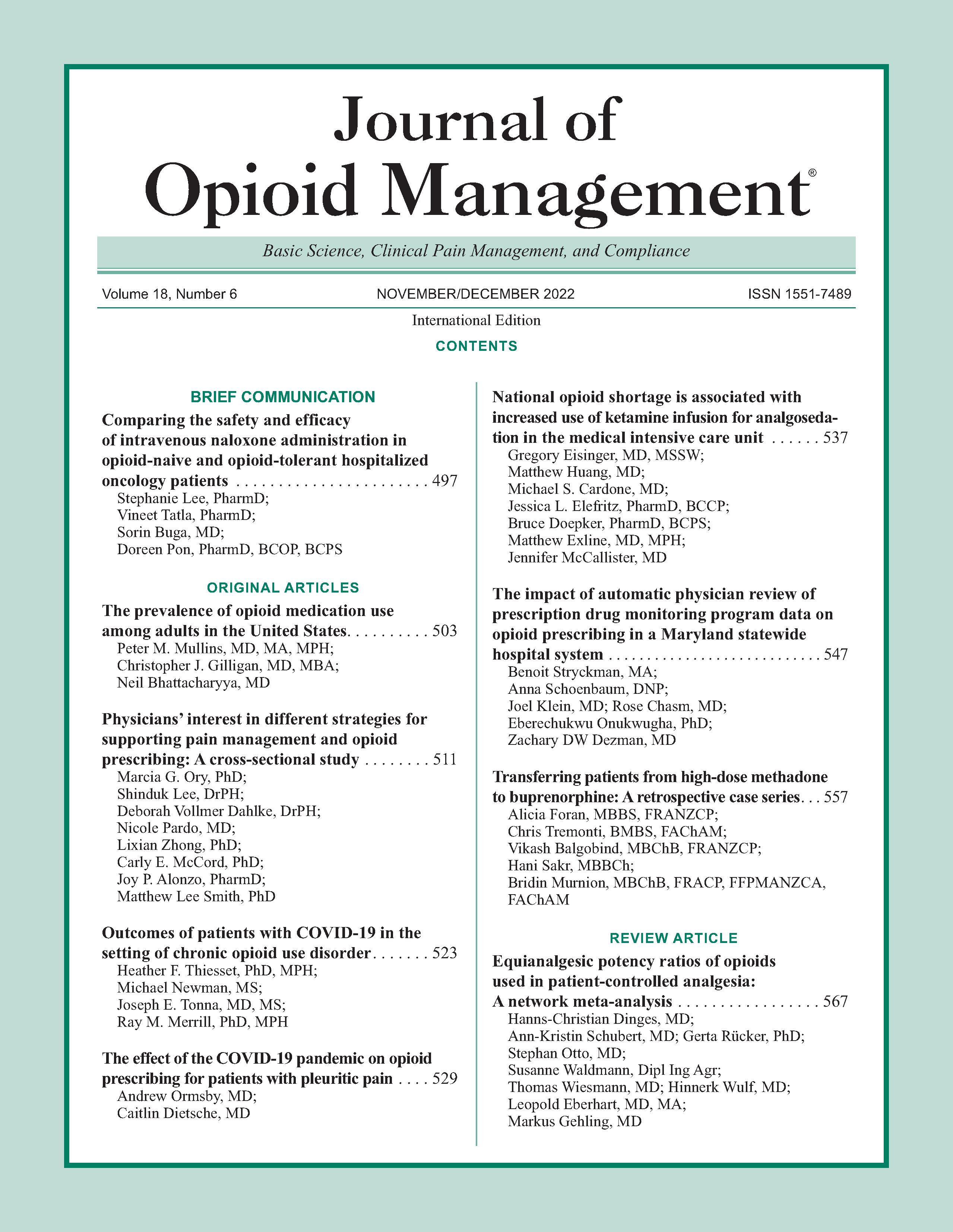The impact of automatic physician review of prescription drug monitoring program data on opioid prescribing in a Maryland statewide hospital system
DOI:
https://doi.org/10.5055/jom.2022.0750Keywords:
prescription opioids, policy, physician drug monitoring program, interrupted time series, healthcare systemAbstract
Background and aims: Prescription drug monitoring programs (PDMPs) were implemented to decrease dangerous opioid prescribing but have had variable results. This report details how automatic PDMP review changed opioid prescribing across a statewide medical system.
Design: An observational study.
Setting: Fourteen hospital networks in the United States.
Cases: Healthcare encountered from July 1, 2016 to June 30, 2019.
Intervention: Starting from July 1, 2018, the patient’s PDMP data would be displayed automatically to providers in the unified electronic medical record (EMR) whenever the provider began to write for an opioid prescription.
Measurements: Outcomes were prescriptions per encounter (PPE) and the morphine milligram equivalents (MME) per prescription. Outcomes were stratified by practice location, medication prescribed, and diagnosis. All data, including whether the prompt was triggered for a given encounter and whether a prescription was given, were extracted from the EMR. An interrupted time-series analysis was used to determine how PPE and MME changed in response to the implementation of automatic PDMP review.
Findings: Of the 624,488 encounters examined, 18.37 percent (n = 114,710) were in emergency departments, 56.79 percent were admissions (n = 354,634), and 24.84 percent (n = 155,144) were outpatient visits. Opioid prescriptions were started and then canceled 24 percent of the time after the PDMP was shown. There was a decline in MME (βOverall + Policy Trends = –3.17, p = <0.0001), which was driven by inpatient (βOverall + Policy Trends = –2.10, p < 0.0001) and outpatient providers (βOverall + Policy Trends = –3.24, p < 0.01). A decline in MME was seen in all medication categories (–1.72 < βOverall + Policy Trends < –5.87, p < 0.01). There were no changes in these trends after excluding encounters for severe and acute pain.
Conclusions: Automated PDMP review is associated with fewer prescriptions and smaller doses without decreasing appropriate use.
References
CDC WONDER: Available at https://wonder.cdc.gov/. Accessed May 10, 2020.
Prescription Drug Monitoring Program Center of Excellence at Brandeis: Mandating PDMP participation by medical providers: Current status and experience in selected states [internet]. Waltham, MA: The Center, 2014. COE Briefing. Available at http://www.pdmpexcellence.org/sites/all/pdfs/COE_briefing_mandates_2nd_rev.pdf. Accessed June 3, 2022.
CRISP: Chesapeake regional information system for our patients. Available at https://www.crisphealth.org/. Accessed May 10, 2020.
2017 Maryland Code: Health—General; Title 21—Food, Drugs, and Cosmetics; Subtitle 2A—Prescription Drug Monitoring Program; § 21-2A-04.2. Prescription monitoring by prescribers [Section subject to abrogation effective June 30, 2023, subject to contingency]. (Section effective on receipt of notice.). Justia Law. Available at https://law.justia.com/codes/maryland/2017/health-general/title-21/subtitle-2a/section-21-2a-04.2/. Accessed September 28, 2020.
Clinical Classifications Software Refined (CCSR): Healthcare Cost and Utilization Project (HCUP). Rockville, MD: Agency for Healthcare Research and Quality, 2020. Available at www.hcup-us.ahrq.gov/toolssoftware/ccsr/ccs_refined.jsp. Accessed June 3, 2022.
Hategeka C, Ruton H, Karamouzian M, et al.: Use of interrupted time series methods in the evaluation of health system quality improvement interventions: A methodological systematic review. BMJ Glob Health. 2020; 5(10): e003567.
Baehren DF, Marco CA, Droz DE, et al.: A statewide prescription monitoring program affects emergency department prescribing behaviors. Ann Emerg Med. 2010; 56(1): 19-23.e3.
Wen H, Hockenberry JM, Jeng PJ, et al.: Prescription drug monitoring program mandates: Impact on opioid prescribing and related hospital use. Health Aff (Millwood). 2019; 38(9): 1550-1556. DOI: 10.1377/hlthaff.2019.00103.
Strickler GK, Zhang K, Halpin JF, et al.: Effects of mandatory prescription drug monitoring program (PDMP) use laws on prescriber registration and use and on risky prescribing. Drug Alcohol Depend. 2019; 199: 1-9.
Sun BC, Charlesworth CJ, Lupulescu-Mann N, et al.: Impact of automated prescription drug monitoring program queries on emergency department opioid prescribing. Ann Emerg Med. 2018; 71(3): 337-347.e6.
Finley EP, Schneegans S, Tami C, et al.: Implementing prescription drug monitoring and other clinical decision support for opioid risk mitigation in a military health care setting: A qualitative feasibility study. J Am Med Inform Assoc. 2018; 25(5): 515-522.
Yuanhong Lai A, Smith KC, Vernick JS, et al.: Perceived unintended consequences of prescription drug monitoring programs. Substance Use Misuse. 2019; 54(2): 345-349.
Rhodes EWM, Robinson A, Hayden JA, et al.: The effectiveness of prescription drug monitoring programs at reducing opioid-related harms and consequences: A systematic review. BMC Health Serv Res. 2019; 19(1): 1-11.
Published
How to Cite
Issue
Section
License
Copyright 2005-2025, Weston Medical Publishing, LLC and Journal of Opioid Management. All Rights Reserved.











